
Kyoto’s ancient Ninnaji Temple is offering a second chance to grab these gorgeously intricate and exclusive papercut designs.
In Japan, visiting Shinto shrines and Buddhist temples around the country is a popular hobby for many people. Upon visiting a location, for a small fee you can purchase goshuin, seal stamps with handwritten calligraphy, which serve as a record that you’ve visited a particular shrine or temple. Most people then store their goshuin inside of a goshuincho record book for safekeeping.
▼ Various examples of go-shuin with the date of visit clearly noted…

▼ …and the goshuincho in which they’re stored!

This summer, Ninnaji Temple in Kyoto is offering a unique take on goshuin with two gorgeous seal stamps limited to the summertime that were designed in consultation with Elternal Co. Ltd., a business venture from Waseda University. Founded in 888 AD, the temple serves as the head temple for the Omuro School of the Shingon Sect of Buddhism. Most of its surviving buildings today, including the five-storied pagoda on the grounds, date from the 17th century during the Edo period (1603-1868) of Japanese history. It’s also one of the 17 locations in the nearby cities of Kyoto, Uji, and Otsu that have been collectively designated the Historic Monuments of Ancient Kyoto, as well as being conferred as a UNESCO World Heritage Site in 1994.
▼ A view of Ninnaji Temple
Ninnaji Temple’s go-shuin are unique in that they don’t feature the typical plain background or upright rectangular shape of typical goshuin but are instead made of special kirie (the art of cutting paper) designs on colored paper. While the goshuin have been available since June 20, their remaining stock is low due to massive popularity largely propelled by word of mouth over social media. Happily, however, it was recently announced that they’re being reordered for more people to purchase during the remainder of the summer.
The first kirie goshuin is titled “Water and Goldfish ~Cool Breeze~” and it depicts goldfish swimming elegantly in a round pool framed by morning glory flowers, a common symbol of summer in Japan. The paper is bright blue with gold accents for the fish and is meant to evoke a feeling of coolness.
The second one is titled “Summer Night Sky and Five-Storied Pagoda ~Elegance~” and it depicts a woman in a yukata gazing up at a five-storied pagoda surrounded by sunflowers and the night sky, including a glimpse of the glittering Milky Way. Part of its charm is that it’s impossible to tell whether the picture is of a modern depiction of a woman at Ninnaji Temple or if it’s of someone in years gone by.
Ninnaji Temple is hoping that the beautiful kirie goshuin will be a treat for both long-time collectors of goshuin and will also inspire new people to begin collecting them as well. You might also be interested to know that there are other variations of goshuin/goshuincho offered throughout Japan as well, including this tetsuincho by a railway in Fukuoka Prefecture for all of the train enthusiasts out there.
Source, images: PR Times
● Want to hear about SoraNews24’s latest articles as soon as they’re published? Follow us on Facebook and Twitter!




 Miss school field trips? Now adults can go on a “school trip” too with new plan at Nara hotel
Miss school field trips? Now adults can go on a “school trip” too with new plan at Nara hotel Testing Japan’s gacha capsule toy calligraphy brushes – tranquility for just 200 yen【Photos】
Testing Japan’s gacha capsule toy calligraphy brushes – tranquility for just 200 yen【Photos】 Add some Japanese architecture to your dinner table with beautiful pagoda dinnerware sets
Add some Japanese architecture to your dinner table with beautiful pagoda dinnerware sets Terahaku aims to be the Airbnb of Japanese temples
Terahaku aims to be the Airbnb of Japanese temples Amazing pics from Kyoto/Nara “bullet tour” show no matter how tight your schedule, you should go
Amazing pics from Kyoto/Nara “bullet tour” show no matter how tight your schedule, you should go Foreigner’s request for help in Tokyo makes us sad for the state of society
Foreigner’s request for help in Tokyo makes us sad for the state of society Japanese city loses residents’ personal data, which was on paper being transported on a windy day
Japanese city loses residents’ personal data, which was on paper being transported on a windy day Seaside scenery, history, and so many desserts on Yokohama’s Akai Kutsu【Japan Loop Buses】
Seaside scenery, history, and so many desserts on Yokohama’s Akai Kutsu【Japan Loop Buses】 Should you add tartar sauce to Japanese curry rice? CoCo Ichi makes diners an unusual offer
Should you add tartar sauce to Japanese curry rice? CoCo Ichi makes diners an unusual offer Red light district sushi restaurant in Tokyo shows us just how wrong we were about it
Red light district sushi restaurant in Tokyo shows us just how wrong we were about it Mt. Koya planning to instate visitor’s tax to cope with huge tourist numbers
Mt. Koya planning to instate visitor’s tax to cope with huge tourist numbers McDonald’s new Happy Meals offer up cute and practical Sanrio lifestyle goods
McDonald’s new Happy Meals offer up cute and practical Sanrio lifestyle goods Historical figures get manga makeovers from artists of Spy x Family, My Hero Academia and more
Historical figures get manga makeovers from artists of Spy x Family, My Hero Academia and more New sleep cafe opens in Japan, offers free coffee and luxurious naps to visitors
New sleep cafe opens in Japan, offers free coffee and luxurious naps to visitors Why are the Los Angeles Dodgers wearing the caps from Nagoya’s professional baseball team?
Why are the Los Angeles Dodgers wearing the caps from Nagoya’s professional baseball team? Japanese ramen restaurants under pressure from new yen banknotes
Japanese ramen restaurants under pressure from new yen banknotes French Fries Bread in Tokyo’s Shibuya becomes a hit on social media
French Fries Bread in Tokyo’s Shibuya becomes a hit on social media Studio Ghibli releases new action figures featuring Nausicaä of the Valley of the Wind characters
Studio Ghibli releases new action figures featuring Nausicaä of the Valley of the Wind characters New private rooms on Tokaido Shinkansen change the way we travel from Tokyo to Kyoto
New private rooms on Tokaido Shinkansen change the way we travel from Tokyo to Kyoto Tokyo Tsukiji fish market site to be redeveloped with 50,000-seat stadium, hotel, shopping center
Tokyo Tsukiji fish market site to be redeveloped with 50,000-seat stadium, hotel, shopping center All-you-can-drink Starbucks and amazing views part of Tokyo’s new 170 meter-high sky lounge
All-you-can-drink Starbucks and amazing views part of Tokyo’s new 170 meter-high sky lounge Beautiful Ghibli sealing wax kits let you create accessories and elegant letter decorations【Pics】
Beautiful Ghibli sealing wax kits let you create accessories and elegant letter decorations【Pics】 Studio Ghibli releases Kiki’s Delivery Service chocolate cake pouches in Japan
Studio Ghibli releases Kiki’s Delivery Service chocolate cake pouches in Japan New definition of “Japanese whiskey” goes into effect to prevent fakes from fooling overseas buyers
New definition of “Japanese whiskey” goes into effect to prevent fakes from fooling overseas buyers Our Japanese reporter visits Costco in the U.S., finds super American and very Japanese things
Our Japanese reporter visits Costco in the U.S., finds super American and very Japanese things Studio Ghibli unveils Mother’s Day gift set that captures the love in My Neighbour Totoro
Studio Ghibli unveils Mother’s Day gift set that captures the love in My Neighbour Totoro More foreign tourists than ever before in history visited Japan last month
More foreign tourists than ever before in history visited Japan last month New Pokémon cakes let you eat your way through Pikachu and all the Eevee evolutions
New Pokémon cakes let you eat your way through Pikachu and all the Eevee evolutions Sales of Japan’s most convenient train ticket/shopping payment cards suspended indefinitely
Sales of Japan’s most convenient train ticket/shopping payment cards suspended indefinitely Sold-out Studio Ghibli desktop humidifiers are back so Totoro can help you through the dry season
Sold-out Studio Ghibli desktop humidifiers are back so Totoro can help you through the dry season Japanese government to make first change to romanization spelling rules since the 1950s
Japanese government to make first change to romanization spelling rules since the 1950s Ghibli founders Toshio Suzuki and Hayao Miyazaki contribute to Japanese whisky Totoro label design
Ghibli founders Toshio Suzuki and Hayao Miyazaki contribute to Japanese whisky Totoro label design Doraemon found buried at sea as scene from 1993 anime becomes real life【Photos】
Doraemon found buried at sea as scene from 1993 anime becomes real life【Photos】 Tokyo’s most famous Starbucks is closed
Tokyo’s most famous Starbucks is closed One Piece characters’ nationalities revealed, but fans have mixed opinions
One Piece characters’ nationalities revealed, but fans have mixed opinions We asked a Uniqlo employee what four things we should buy and their suggestions didn’t disappoint
We asked a Uniqlo employee what four things we should buy and their suggestions didn’t disappoint Princesses, fruits, and blacksmiths: Study reveals the 30 most unusual family names in Japan
Princesses, fruits, and blacksmiths: Study reveals the 30 most unusual family names in Japan 3-D paper-cutting artist shows off masterpieces made from single piece of paper【Pics】
3-D paper-cutting artist shows off masterpieces made from single piece of paper【Pics】 Giant temple in mountains of Japan is also one of its most impressive tapioca bubble tea cafes
Giant temple in mountains of Japan is also one of its most impressive tapioca bubble tea cafes Dress like an aristocrat from the Nara period at new costume rental shop in Nara【Photos】
Dress like an aristocrat from the Nara period at new costume rental shop in Nara【Photos】 Art Aquarium Ginza offers a captivating new way to enjoy the cherry blossoms–with goldfish!
Art Aquarium Ginza offers a captivating new way to enjoy the cherry blossoms–with goldfish! Tokyo temple holds funeral for personal seals in effort to reform outdated business practice【Vid】
Tokyo temple holds funeral for personal seals in effort to reform outdated business practice【Vid】 Kyoto temple goes modern with Techno Memorial combining music and lights with Buddhist Festival
Kyoto temple goes modern with Techno Memorial combining music and lights with Buddhist Festival Purify the hate of Internet jeers with Japanese temple’s first online ceremonial fire
Purify the hate of Internet jeers with Japanese temple’s first online ceremonial fire Our writer Meg gets a taste of Kiri Cafe, a cream cheese-lover’s paradise!
Our writer Meg gets a taste of Kiri Cafe, a cream cheese-lover’s paradise! The most popular places in Japan for viewing sakura in 2024, according to local travel agency
The most popular places in Japan for viewing sakura in 2024, according to local travel agency Earn points by visiting temples throughout Japan with Buddhist sect’s upcoming app
Earn points by visiting temples throughout Japan with Buddhist sect’s upcoming app TripAdvisor Japan announces the country’s 10 favorite shrines and temples
TripAdvisor Japan announces the country’s 10 favorite shrines and temples Real Buddhist monk shows off hot (and sweet) EDM dance moves in Mount Koya video
Real Buddhist monk shows off hot (and sweet) EDM dance moves in Mount Koya video Kyoto in summer: A special trip to Kifune shrine recharges the soul
Kyoto in summer: A special trip to Kifune shrine recharges the soul This beautiful video displays two very different sides of Japan【Video】
This beautiful video displays two very different sides of Japan【Video】 Refresh your mind, body, and soul at Temple Camp Daitaiji, the first temple to open to campers
Refresh your mind, body, and soul at Temple Camp Daitaiji, the first temple to open to campers A visit to Japan’s centuries-old boob temple
A visit to Japan’s centuries-old boob temple
Leave a Reply